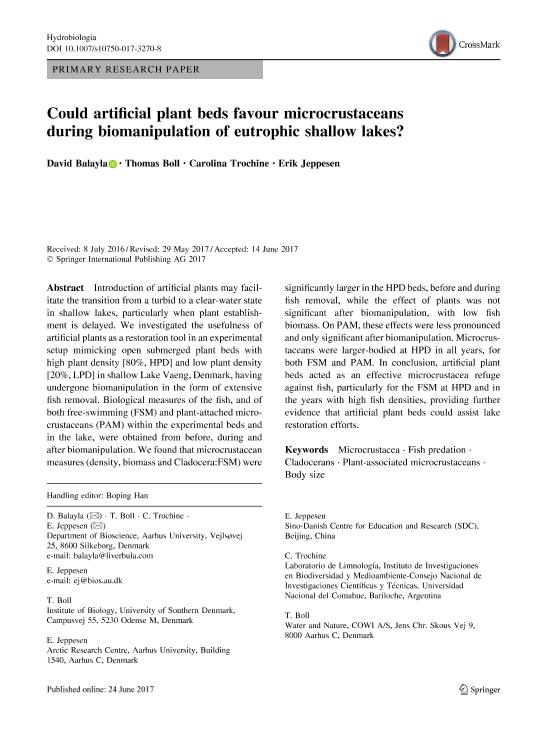Mostrar el registro sencillo del ítem
dc.contributor.author
Balayla, David
dc.contributor.author
Boll, Thomas
dc.contributor.author
Trochine, Carolina

dc.contributor.author
Jeppesen, Erik
dc.date.available
2018-11-06T18:29:33Z
dc.date.issued
2017-11
dc.identifier.citation
Balayla, David; Boll, Thomas; Trochine, Carolina; Jeppesen, Erik; Could artificial plant beds favour microcrustaceans during biomanipulation of eutrophic shallow lakes?; Springer; Hydrobiologia; 802; 1; 11-2017; 221-233
dc.identifier.issn
0018-8158
dc.identifier.uri
http://hdl.handle.net/11336/63790
dc.description.abstract
Introduction of artificial plants may facilitate the transition from a turbid to a clear-water state in shallow lakes, particularly when plant establishment is delayed. We investigated the usefulness of artificial plants as a restoration tool in an experimental setup mimicking open submerged plant beds with high plant density [80%, HPD] and low plant density [20%, LPD] in shallow Lake Vaeng, Denmark, having undergone biomanipulation in the form of extensive fish removal. Biological measures of the fish, and of both free-swimming (FSM) and plant-attached microcrustaceans (PAM) within the experimental beds and in the lake, were obtained from before, during and after biomanipulation. We found that microcrustacean measures (density, biomass and Cladocera:FSM) were significantly larger in the HPD beds, before and during fish removal, while the effect of plants was not significant after biomanipulation, with low fish biomass. On PAM, these effects were less pronounced and only significant after biomanipulation. Microcrustaceans were larger-bodied at HPD in all years, for both FSM and PAM. In conclusion, artificial plant beds acted as an effective microcrustacea refuge against fish, particularly for the FSM at HPD and in the years with high fish densities, providing further evidence that artificial plant beds could assist lake restoration efforts.
dc.format
application/pdf
dc.language.iso
eng
dc.publisher
Springer

dc.rights
info:eu-repo/semantics/openAccess
dc.rights.uri
https://creativecommons.org/licenses/by-nc-sa/2.5/ar/
dc.subject
Body Size
dc.subject
Cladocerans
dc.subject
Fish Predation
dc.subject
Microcrustacea
dc.subject
Plant-Associated Microcrustaceans
dc.subject.classification
Otras Ciencias Biológicas

dc.subject.classification
Ciencias Biológicas

dc.subject.classification
CIENCIAS NATURALES Y EXACTAS

dc.title
Could artificial plant beds favour microcrustaceans during biomanipulation of eutrophic shallow lakes?
dc.type
info:eu-repo/semantics/article
dc.type
info:ar-repo/semantics/artículo
dc.type
info:eu-repo/semantics/publishedVersion
dc.date.updated
2018-10-23T16:16:43Z
dc.journal.volume
802
dc.journal.number
1
dc.journal.pagination
221-233
dc.journal.pais
Alemania

dc.journal.ciudad
Berlin
dc.description.fil
Fil: Balayla, David. University Aarhus; Dinamarca
dc.description.fil
Fil: Boll, Thomas. University Aarhus; Dinamarca. University of Southern Denmark; Dinamarca
dc.description.fil
Fil: Trochine, Carolina. Consejo Nacional de Investigaciones Científicas y Técnicas. Centro Científico Tecnológico Conicet - Patagonia Norte. Instituto de Investigaciones en Biodiversidad y Medioambiente. Universidad Nacional del Comahue. Centro Regional Universidad Bariloche. Instituto de Investigaciones en Biodiversidad y Medioambiente; Argentina. University Aarhus; Dinamarca
dc.description.fil
Fil: Jeppesen, Erik. University Aarhus; Dinamarca. Sino-Danish Centre for Education and Research; China
dc.journal.title
Hydrobiologia

dc.relation.alternativeid
info:eu-repo/semantics/altIdentifier/doi/http://dx.doi.org/10.1007/s10750-017-3270-8
dc.relation.alternativeid
info:eu-repo/semantics/altIdentifier/url/https://link.springer.com/article/10.1007%2Fs10750-017-3270-8
Archivos asociados
